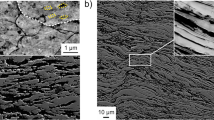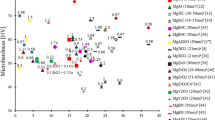Abstract
Magnesium is one of the most promising lightweight materials. However, its competitiveness has been severely reduced by the poor corrosion resistance, low strength, poor deformability, and formability. Here, we propose to design a novel magnesium-based composite prepared by the powder metallurgy using the magnesium nanoparticles with a MgCO3 protective layer, which can be obtained via the transformation from the native or corroded surface at room temperature and may effectively improve the anti-corrosion as well as deformability of submicron-scale magnesium.
Access provided by Autonomous University of Puebla. Download conference paper PDF
Similar content being viewed by others
Keywords
Introduction
Magnesium has been widely recognized as one of the most potential lightweighting materials and is desirable in applications ranging from automotive, 3C products, air/space industry etc. [1,2,3]. However, the lightest structural metal suffers from some intrinsic issues, such as the poor corrosion resistance, low strength, poor room temperature deformability and formability. One primary reason for the inadequate corrosion resistance of magnesium is that the native surface film formed in the air mainly consists of Mg(OH)2 and MgO, which is porous and unprotective, especially in the humid environment [4, 5]. Therefore, one of the widely applied strategies in industry to protect magnesium based materials from corrosion is to create a surface coating, as a barrier to isolate Mg metal from the external environmental attack [6, 7]. Nevertheless, most of the coatings have little to do with improving the ductility and strength of magnesium, or even deteriorate the mechanical property of magnesium surface [8]. Recently, the nanoscale magnesium carbonate (MgCO3) layer on magnesium surface has been found that it can effectively improve the anti-corrosion performance of magnesium alloys, and meanwhile this protective layer can elevate the yield stress, suppress plastic instability and prolong compressive strains without cracking or peeling off from the surface of the small-sized magnesium [9]. Inspired by this finding, we propose to design a novel magnesium composite composed of the magnesium nanoparticles with the thin MgCO3 layer on individual nanoparticles. The composite is expected to have good corrosion resistance, improved deformability and strength.
Experimental
Observation of the reaction process of Mg oxide or hydroxide with CO2 at room temperature was conducted by the environmental transmission electron microscope (E-TEM, Hitachi H9500). The carbonation was done after the 20 min exposure to the 300 keV, 0.1 A/cm2 electron beam irradiation in 4 Pa CO2 atmosphere. The Mg alloy micropillar was firstly fabricated via the focused ion beam milling and then immersed in deionized water for about 1 min, after which the fluffy corroded surface mainly composed of Mg hydroxide can be obtained.
Results and Discussion
In principle, MgCO3 can be obtained via the chemical reaction, MgO + CO2 → MgCO3, which usually occurs at high temperatures of 400 °C or above [10]. We have found a way to transform the magnesium oxide/hydroxide or the corroded surface into MgCO3 barrier layer, without extra heating [9, 11]. Figure 1 shows the room temperature transformation from aggregated flakes of nanoscale MgO lamella into a piece of dense amorphous product, and the Scanning TEM (STEM) energy disperse spectroscopy (EDS) maps demonstrate that the product is the Mg carbonate.
a TEM image and diffraction pattern of MgO crystal flakes. b After the 20 min exposure to the electron beam irradiation in 4 Pa CO2 atmosphere, the MgO flakes were transformed into a piece of amorphous product with many bubbles. c STEM EDS maps showing the elements distribution of Mg, C and O in the product
Not only the magnesium oxide but also the magnesium hydroxide can react with the CO2 excited by the high-energy electron beam. Figure 2a demonstrates the TEM image of magnesium, which was pre-corroded in the deionized water for 1 min and has the fluffy hydroxide corrosion product on its surface. After the CO2 gas was flown into the environmental TEM chamber, the fluffy Mg(OH)2 gradually shrank around the pillar due to reaction with CO2. The reaction product—MgCO3 wrapped around the metal, resulting in a smooth surface (Fig. 2b–c). Our preliminary work has testified the protective effect of the MgCO3 layer as the anti-corrosion barrier in aqueous environments [9]. However, being a ceramic material, bulk MgCO3 is intrinsically brittle, and how about the deformation behavior of its nanoscale counterpart?
The amorphous MgCO3 transformed from the carbonation of magnesium oxide was bridge tangled between two broken parts of the supporting holey carbon film deposited on the copper TEM grid. Under electron beam irradiation, a pulling force was generated when the carbon film is being illuminated and the in situ tensile deformation was captured. Figure 3a–d show the superplastic flow experienced by MgCO3 during the tensile deformation. Noted that the nano-bubbles in MgCO3 are the unescaped CO2 gas during reaction. The superplastic MgCO3 layer on magnesium surface has been found to be able to elevate the yield stress, suppress plastic instability and prolong compressive strains without peeling off from the submicron-scale magnesium metal substrate [9].
Besides the expensive high-energy electron beam, CO2 gas can also be excited by the dielectric discharge or glow discharge as well, existing in the non-thermal plasma state, and react with magnesium oxide or hydroxide without extra heating [9, 11, 12]. This inspires us to scale up our findings inside TEM for designing a bulk magnesium based material with good comprehensive performances, such as the high corrosion resistance, high strength, and deformability. Figure 4 shows the design idea schematically. First, the magnesium nanoparticles with the air-formed oxide/hydroxide film are treated in the non-thermal CO2 plasma (carbonation process), after which the nanoparticles are magnesium carbonate coated. The magnesium nanoparticles can be synthesized by cryomilling [13], and the average size of magnesium nanoparticles should be 100 nm or below, since it was reported that the small dimensions lead to high strengths and more uniform deformation of magnesium by promoting the latent hardening and dislocation storage, resulting in high ductility [14]. Secondly, consolidating magnesium nanoparticles with MgCO3 coating. Spark plasma sintering (SPS), which has been proved to be able to effectively sinter nanoparticles into a dense bulk at low temperatures very quickly with the preservation of the nanocrystalline microstructure [15], can be used for the consolidation. The core of this technique is considerable electric currents and the uniaxial pressure loading at the same time [16].
Turing the brittle native magnesium oxide into the ductile amorphous MgCO3 on magnesium surface is expected to inhibit the embrittlement of the powder metallurgy magnesium caused by the inevitable oxide introduction [17].
Summary
Via carbonation of the air-formed porous oxide/hydroxide film or hydrate corrosion products on magnesium at room temperature, a compact amorphous MgCO3 layer, which demonstrates the incredible plastic deformability and can well protect the magnesium substrate free from the aqueous corrosion, has been obtained. Inspired by this, we propose to design a powder metallurgy magnesium composite by consolidating the magnesium nanoparticles with the nanoscale MgCO3 coating. The novel magnesium based composite is expected to be corrosion resistant and meanwhile have improved strength and good deformability.
References
Knochel P. A flash of magnesium. Nature Chemistry (2009) 740–740.
Esmaily M, Svensson JE, Fajardo S, Birbilis N, Frankel GS, Virtanen S, Arrabal R, Thomas S, Johansson LG. Fundamentals and advances in magnesium alloy corrosion. Progress in Materials Science 89 (2017) 92–193.
Pollock TM. Weight loss with magnesium alloys. Science 328 (2010) 986–987.
Nordlien J, Ono S, Masuko N, Nisancioglu K. A TEM investigation of naturally formed oxide films on pure magnesium. Corrosion science 39 (1997) 1397–1414.
Nordlien JH, Nisancioglu K, Ono S, Masuko N. Morphology and Structure of Water‐Formed Oxides on Ternary MgAl Alloys. Journal of the Electrochemical Society 144 (1997) 461–466.
Gray J, Luan B. Protective coatings on magnesium and its alloys—a critical review. Journal of alloys and compounds 336 (2002) 88–113.
Hu R-G, Zhang S, Bu J-F, Lin C-J, Song G-L. Recent progress in corrosion protection of magnesium alloys by organic coatings. Progress in Organic Coatings 73 (2012) 129–141.
Gray JE, Luan B. Protective coatings on magnesium and its alloys-a critical review. Journal of Alloys & Compounds 336 (2002) 0–113.
Wang Y, Liu B, Zhao Xa, Zhang X, Miao Y, Yang N, Yang B, Zhang L, Kuang W, Li J. Turning a native or corroded Mg alloy surface into an anti-corrosion coating in excited CO2. Nature communications 9 (2018) 4058.
Feng B, An H, Tan E. Screening of CO2 adsorbing materials for zero emission power generation systems. Energy & Fuels 21 (2007) 426–434.
Zhang L, Tang Y, Peng Q, Yang T, Liu Q, Wang Y, Li Y, Du C, Sun Y, Cui L. Ceramic nanowelding. Nature communications 9 (2018) 96.
Gupta P, Tenhundfeld G, Daigle EO. Electrolytic plasma technology: Science and engineering - an overview. Surface & Coatings Technology 201 (2007) 8746–8760.
Park YS, Chung KH, Kim NJ, Lavernia EJ. Microstructural investigation of nanocrystalline bulk Al–Mg alloy fabricated by cryomilling and extrusion. Materials Science & Engineering A 374 (2004) 211–216.
Qian Y, Liang Q, Mishra RK, Ju L, Minor AM. Reducing deformation anisotropy to achieve ultrahigh strength and ductility in Mg at the nanoscale. Pnas 110 (2013) 13289–13293.
Ye J, Ajdelsztajn L, Schoenung JM. Bulk nanocrystalline aluminum 5083 alloy fabricated by a novel technique: Cryomilling and spark plasma sintering. Metallurgical & Materials Transactions A 37 (2006) 2569–2579.
Munir ZA, Anselmi-Tamburini U, Ohyanagi M. The effect of electric field and pressure on the synthesis and consolidation of materials: A review of the spark plasma sintering method. Journal of Materials Science 41 (2006) 763–777.
Kondoh K, Fukuda H, Umeda J, Imai H, Fugetsu B, Endo M. Microstructural and mechanical analysis of carbon nanotube reinforced magnesium alloy powder composites. Materials Science & Engineering A 527 (2010) 4103–4108.
Acknowledgements
The authors acknowledge the support provided by grants from NSFC (51902249, 51621063). The authors also thank the supports from the National Key Research and Development Program of China (No. 2017YFB0702001) and Technology Department of Shaanxi Province (2016KTZDGY-04-03 and 2016KTZDGY-04-04). We also appreciate the support from the 111 project (B06025).
Author information
Authors and Affiliations
Corresponding author
Editor information
Editors and Affiliations
Rights and permissions
Copyright information
© 2020 The Minerals, Metals & Materials Society
About this paper
Cite this paper
Wang, YC., Liu, BY., Shan, ZW. (2020). Design of the Magnesium Composite with High Corrosion Resistance and High Deformability. In: Jordon, J., Miller, V., Joshi, V., Neelameggham, N. (eds) Magnesium Technology 2020. The Minerals, Metals & Materials Series. Springer, Cham. https://doi.org/10.1007/978-3-030-36647-6_36
Download citation
DOI: https://doi.org/10.1007/978-3-030-36647-6_36
Published:
Publisher Name: Springer, Cham
Print ISBN: 978-3-030-36646-9
Online ISBN: 978-3-030-36647-6
eBook Packages: Chemistry and Materials ScienceChemistry and Material Science (R0)








